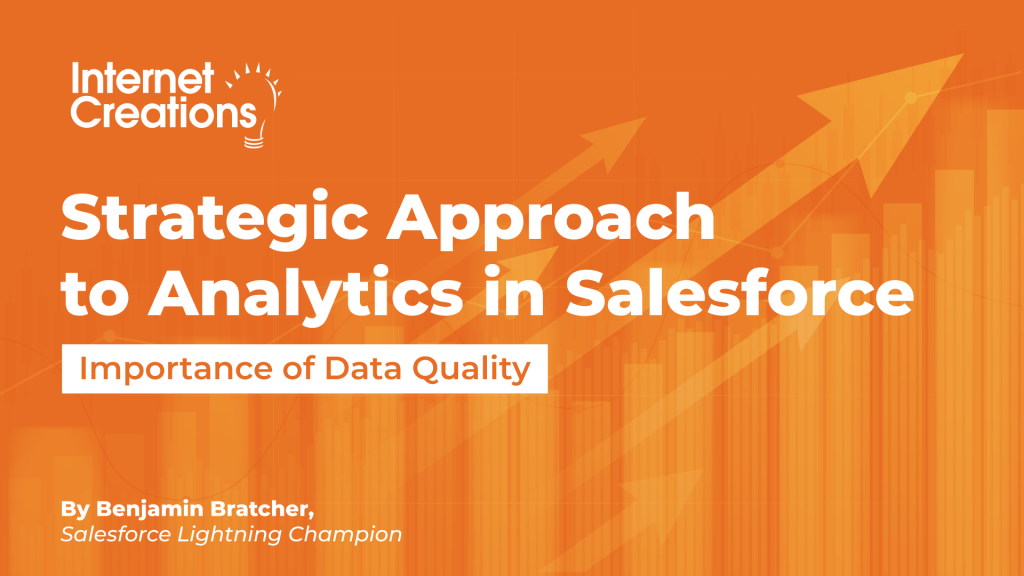Importance of Data Quality

Author’s Note: This blog post is part of the Strategic Approach to Analytics in Salesforce series, which features the strategic approach to analytics of six leaders at Internet Creations. To view the entire series, click here.

For better decision-making, you need good dashboards that will give you insight into your company’s data. To make good dashboards, you need reliable data.
“Bad data is not only a technology problem, but also a people problem.”
– George Guhr, Director of Sales
As George points out, the issue with bad data is related to people in addition to technology. Bad data stinks and is a struggle that everyone has. But according to George, the best way that you get past the problem isn’t with validation rules in Salesforce, but by holding people accountable for it. Too many validation rules can hold people up, too. To get to the root of the problem, you can set proper expectations and get the issue into a visible place.
So, how can you remedy bad data? Here are seven ways to fix or avoid bad data:
1. Exception Analytics
George suggests creating an exception dashboard to identify “crappy data” and keep people on tasks and identify data integrity issues. Similarly, Howard suggests using a case cleanliness checklist, which his team keeps a copy of on their desk. This checklist ensures that certain fields and steps were completed when working a case. Howard reviews his case subjects report weekly and will do small pokes with his team when he sees issues. Anthony suggests scheduling exception reports to be sent, so people only receive the report when certain conditions are met. “If an employee receives the report, they know there’s action to be taken,” says Anthony.
2. Executive Support
In my conversations with Felisa Palagi, she mentioned the importance of executive support when it comes to championing data quality. IC is fortunate in that Chad Meyer, IC’s founder, has beat the drum that if the data isn’t in Salesforce, it doesn’t exist. This mindset has led to good data quality. Felisa said one of her previous companies used Salesforce, but they didn’t put their info in the CRM and used Excel or, “gasp,” post-it notes instead. It was a 15,000 people company and you couldn’t look into Salesforce to see what was going on. Obviously, the lack of data in Salesforce makes reporting on it and consequently making decisions quite difficult. It is critical that executives promote data quality initiatives at your company.
3. Initiatives
Felisa strongly believes in utilizing initiatives to promote good data. Initiatives are strategic plans to resolve or improve a difficulty. For example, a recent one at IC is the case management initiative in which the leadership team reviews cases with the consultants to ensure everyone is on track. This initiative ensures that the consultants have a manageable workload, have everything they need to be successful, and that the project is going according to plan to ensure a good customer experience. “Behavior starts with the talk,” says Felisa. “It’s important to validate and check data to make sure the right behaviors are happening.” Furthermore, as a leader, you have to lead by example and do the things you are asking your team to do too.
4. Documentation
Another way to ensure good data is by documenting standard operating procedures. Doing this allows for everyone in the organization to follow the same processes and provide the right guidance on what good data looks like. IC has been documenting our entire Salesforce org using Quip, but is in the process of implementing Spekit. Both tools allow for you to directly embed documentation within Salesforce in different ways. By using these types of tools, standard operating procedures are always right there within reach when they are needed, which saves time and allows for easier on-boarding, training, and adoption.
5. Training/Callouts
As we’ve established previously, bad data is also a people problem, so an effective way to remedy it is by training. Felisa uses dashboard snapshots to @mention people about something she sees on that report. This allows for the employee to understand the context of the conversation. Howard has training and regular reviews with his team. Anthony makes sure his team understands why the data is important and how it affects them and the company because they will be more likely to take greater care of their data as a result.
Felisa points out that since the department heads own their dashboards, they are more likely to turn around to the team and ask them for better data. Managers and directors are now empowered to do that as opposed to the CEO reaching out to individual contributors.
6. Gamification
“Rather than treating data quality as a separate task in your day-to-day work, you encourage people to integrate it into their work right away.”
– Howard Yermish, Director of Product
Anthony is a big fan of gamification as a way to drive behavior. Making data issues more apparent can be a useful way to create some fun competition. IC also uses Hoopla, which displays metrics and leaderboards on TVs and also plays a person’s theme song at certain milestones. Lastly, Anthony mentioned Game of Fields as a way to promote gamification.
Howard helped develop Game of Fields as an internal app that allows users to earn points for entering data on prioritized fields. The idea is to gamify data quality in Salesforce. “You’re never going to be as accurate as you were in the moment,” says Howard. “So rather than treating data quality as a separate task in your day-to-day work, you encourage people to integrate it into their work right away.” Howard has high hopes for Game of Fields and thinks adding a scoreboard would increase adoption.
7. Easier Data Entry
You don’t want friction when your users are creating records. Anthony suggests only using validation rules for the key pieces of data that need to be added. Standardization is also recommended to ensure cleaner data. An example of this would be using picklists where possible instead of open text fields (but avoid multi-select picklists!). High touch fields should be on the top of the page, and utilizing the path helps visualize the progress of the record.
Dan Leibowitz mentioned Time Tracker as an example for easier data entry. IC created a lightning component called Time Tracker that lives on the utility bar in Salesforce and allows for accurate and consistent data entry of users’ time.
Stay tuned for more…
If you enjoyed learning about the importance of data quality, make sure to subscribe to the Internet Creations blog by entering your information below. You will receive a monthly digest of blog posts including the next blog posts in the Strategic Approach to Analytics in Salesforce series.
Next up, we will be focusing on Confirmation Bias.
Enter your information to receive monthly updates featuring new posts from Internet Creations’ blog.
- Key Takeaways – Strategic Approach to Analytics - February 10, 2021
- Cross-Departmental Collaboration and Alignment - February 2, 2021
- 22 Tips and Traps with Analytics (with Admin Best Practices) - January 12, 2021


